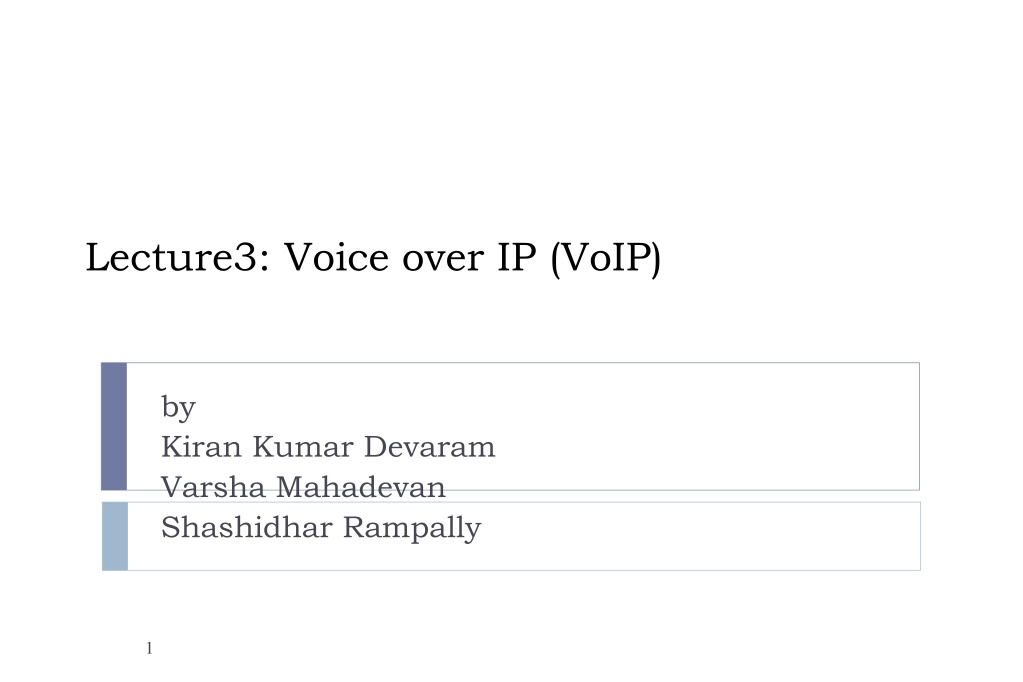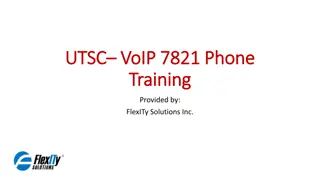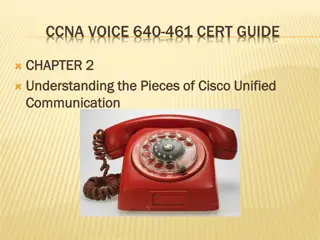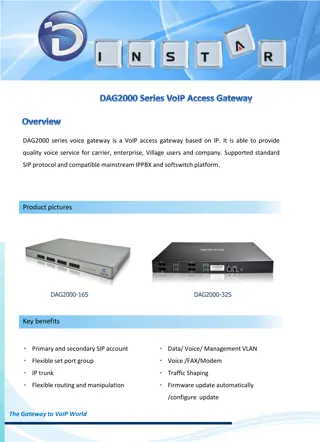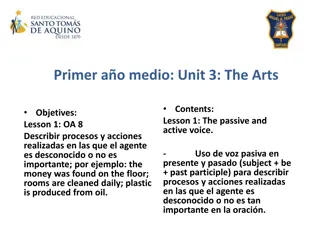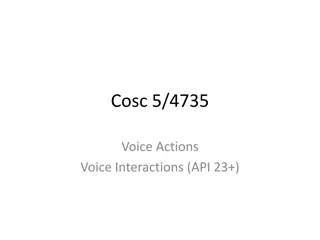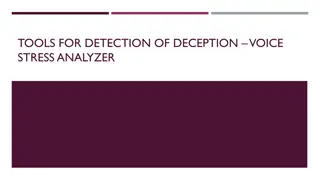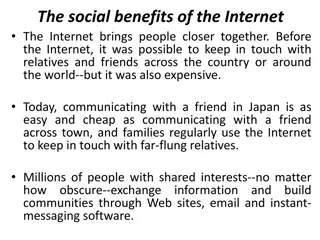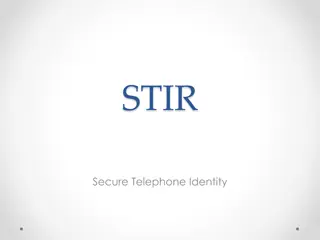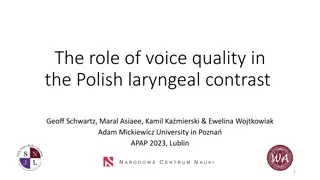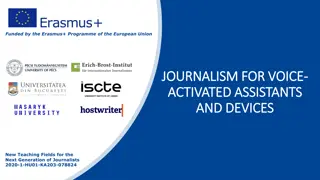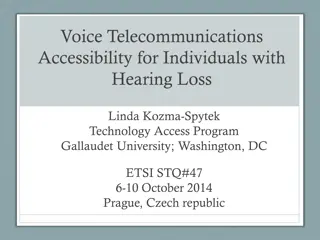Understanding Voice over IP (VoIP) Technology
Explore the world of Voice over IP technology through this comprehensive lecture covering VoIP basics, motivations, implementation methods, configuration options, main issues, standards, and ISO reference model. Learn about VoIP's ability to make calls over IP networks, motivations behind its use, technical aspects of VoIP implementation, and key standards shaping the industry. Discover how VoIP impacts multimedia communication, voice and data network integration, and cost reduction in long-distance calls. Dive into the details of analog to digital voice conversion, voice data compression, network transmission, and more.
Download Presentation

Please find below an Image/Link to download the presentation.
The content on the website is provided AS IS for your information and personal use only. It may not be sold, licensed, or shared on other websites without obtaining consent from the author. Download presentation by click this link. If you encounter any issues during the download, it is possible that the publisher has removed the file from their server.
E N D
Presentation Transcript
Lecture3: Voice over IP (VoIP) by Kiran Kumar Devaram Varsha Mahadevan Shashidhar Rampally 1
Whats VoIP? VoIP is the ability to make telephone calls and send faxes over IP-based data networks with a suitable quality of service and superior cost/benefit. 2
Motivations for VoIP Demand for Multimedia communication Demand for integration of Voice and Data networks Cost Reduction in long distance telephone calls 3
How to VoIP? Analog Digital Voice Compression to less than 32Kbps Transfers through Routers, LAN Switches etc, using their Protocols 4
Voice To/From IP Analog Voice CODEC: Analog to Digital Compress Create Voice Datagram Add Header (RTP, UDP, IP, etc) Digital Network 5
Voice To/From IP Digital Network Process Header Re-sequence and Buffer Delay Decompress CODEC: Digital to Analog Analog Voice 6
Configuration Options Telephone-to-Telephone 7
PC-to-PC 8
Main Issues Quality of Voice Interoperability Security Integration with Public Switched Telephone Network(PSTN) Scalability 10
VoIP Standards ITU H.323 IETF Session Initiation Protocol (SIP) Media Gateway Control (Megaco) Signal Transport (SigTran) 11
ISO Reference Model and VoIP Standards ISO Protocol layer Protocols and standards Presentation Codecs / Applications Session H.323 / SIP / MGCP Transport RTP / TCP / UDP Network IP Link FR, ATM, Ethernet, PPP, HDLC, etc. 12
H.323 Entities Terminals Gateways Gatekeepers Multi-point Control Units (MCU) 13
Terminal Endpoint on a LAN Supports real-time, 2-way communications with another H.323 entity Must support: Voice - audio codecs Signaling and setup Optional support: Video Data 14
Gateway Interface between the LAN and the circuit switched network Translates communication procedures and formats between networks Call setup and clearing Compression and packetization of voice Example: IP/PSTN gateway 15
Gatekeeper Optional (e.g., Netmeeting does not use gatekeepers), but must perform certain functions if present Manage a zone (a collection of H.323 devices) Usually one gatekeeper per zone; alternate gatekeeper might exist for backup and load balancing Typically a software application, implemented on a PC, but can be integrated in a gateway or terminal 16
Multi-point Control Unit (MCU) Endpoint that supports conferences between 3 or more endpoints Can be stand-alone device (e.g., PC) or integrated into a gateway, gatekeeper or terminal Typically consists of multi-point controller (MC) and multi- point processor (MP) MC - handles control and signaling for conference support MP - receives streams from endpoints, processes them, and returns them to the endpoints in the conference 17
H.323 Protocol Stack Transfer of real- time media (audio and video) Registration Control and Signaling 18
VoIP Origination side Analog voice is sent from telephone set to local office. Local switch converts analog signal to PCM and transmits 64kbps bit stream to the gateway. Gateway receives 64kbps bit stream and does the following Compress speech Convert speech samples to datagrams Transmit speech datagram over IP network VoIP Termination side VoIP gateway receives speech datagrams Convert Speech datagram to PCM speech. Transmit 64Kbps PCM speech to Local switch Local switch converts PCM to analog voice and sends it to telephone set 19
H.323 Call Stages Discovery and Registration(RAS) Who am I Call Setup(RAS/H.225/Q.931) Whom I want to call Call Negotiation (H.245) These are our capabilities Media Channel Setup(H.245) Let s open audio channel Media Transport( RTP/RTCP) Send audio datagrams Call termination (H.245/H.225/RAS) We are done 20
Simple VoIP Call Caller Number : 785-537-2736 Called Number : 410-944-511 ITSP Number : 1-888-745-2654 Gateway Trunk Local Loop 785-537-2736 1-888-745-2654 Local Switch Caller dials ITSP toll free number : 1-888-745-2654 Caller gets connected to VoIP gateway of ITSP 21
Simple VoIP Call Gatekeeper ARQ ACF LRQ LCF Gateway 785-537-2736 1-888-745-2654 Local Switch What is the IP address of the destination gateway for 410-944-2511?-LRQ The IP address of the destination gateway is 154.23.78.345. LCF May I call the IP address? ARQ You may use XX Kbps bandwidth - ACF 22
Simple VoIP Call Gatekeeper Connect H.225/Q.931/H.245 Gateway 785-537-2736 Destination Gateway 1-888-745-2654 Local Switch The setup message consists of Originator gateway IP address (129.130.10.123) Destination Gateway IP address (154.23.78.345) Caller-number (785-537-2736) Called-number (410-944-2511) H.245 request: OpenLogicalChannelForAudio 23
Simple VoIP Call Gatekeeper Gateway ACF ARQ 785-537-2736 Destination Gateway 1-888-745-2654 Local Switch Destination gateway makes a request to the gatekeeper to accept the call from the originator May I call the originator gateway IP address? ARQ Yes,You may use XX Kbps bandwidth - ACF 24
Simple VoIP Call Gatekeeper Connect H.225/Q.931/H.245 Gateway 785-537-2736 Destination Gateway 1-888-745-2654 Local Switch Destination gateway sends a connect confirm message. 25
Simple VoIP Call Gatekeeper Local Switch Local Switch Gateway Gateway Destination Gateway establishes PSTN connection with PSTN circuit switch and H.245 audio channel Caller will hear the ringer tone generated by the destination switch 26
SIP: Session Initiation Protocol IETF s Signaling Protocol for real time calls and confernces over IP networks. Integrated heavily w/ Internet technologies such as web (http), email & messaging services, and directory services (LDAP, DNS) Location Independent and hence opted for Mobile Networks SIP is complimentary to MGCP SIP Provides Session Control SGCP/MGCP Provides Device Control 27
SIP Architecture Client/Server in Nature Major Entities User Agent Proxy Server Redirect Server SIP Registrar 28
SIP Entities User Agents User Agent Client (UAC) User Agent Server (UAS) Network Servers 29
SIP Proxy Operation SIP Proxy Server 3. Proxy server looks up phone number or URL to registered called party, SIP server then sends invitation to called party 2. When user picks up phone and dials destination phone number or URL, request is sent to the proxy server 4. Called Client is informed of incoming call by an invitation from proxy server SIP Client SIP Client Caller Callee 5. SIP Clients open RTP session between themselves when the called user picks up the phone 1. SIP Clients registers with SIP servers at login or at boot up 30
SIP Redirect Operation 3. Redirect server looks up phone number or URL to registered called party, SIP server then sends the address back to the call originator SIP Redirect server 2. When user picks up phone and dials destination phone number or URL, request is sent to the redirect server 4. Call originator sends invitation to destination 5. Called client is informed of incoming call by invitation message (Phone ring) SIP Client SIP Client Caller Callee 6.SIP Clients open RTP session between themselves when the called user picks up the phone 1. SIP Clients registers with SIP servers at login or at boot up 31
H.323 vs SIP H.323 SIP Designed for multimedia communication over different types of networks Designed to session b/w two points Philosophy Designed to handle failure of network entities No defined procedures for handling device failure Reliability Encodes in compact binary format Encodes in ASCII text format. Hence easy to debug and process Message Encoding Flexible addressing scheme using URLs and E.164 numbers Understands only URLs style addresses Addressing Monolithic Modular Architecture
QoS Issues One way latency for high quality voice must not be greater than 150ms. Delay greater than 50ms leads to echo and talker overlap. Variation in inter-packet arrival time. The solution to this problem is to introduce jitter buffers. Loss in excess of 5-10% causes significant degradation in voice quality. Delay Jitter Packet Loss Packets may arrive out of order and this leads to garbled speech. Re-ordering
Billing Issues Metered by flow duration, time-of-day, time-of-week Time-based Rated by called and calling station ids associated with the sequence of stages used to support the call Destination, distance, carrier-based Rated by established service parameters such as priority, selected QoS and latency. QoS based
Cost Considerations Cisco 1750 Modular Access Router Ericsson WebSwitch 100 Phone Gateway P4 Multi-Tech Multi VOIP MVP400 Nortel Passport 4430 Multi service Access Switch Price $2,695 $2,695 $1,091 $1,091 $2,999 $2,999 $3,200 $3,200 Product type Router Gateway Gateway Router Up to 6 Up to 6 4 4 Up to 6 Up to 6 Phone ports Yes Yes Optional (with Optional (with external gateway) external gateway) Yes Yes No H.323 support
References http://www.protocols.com/papers/voip.htm http://www.networkmagazine.com/encyclopedia/search?term=IPtelephony ftp://ftp.netlab.ohio-state.edu/pub/jain/courses/cis788- 99/voip_protocols/index.html http://members.tripod.com/taegon/voip/current_problems.htm http://www.itpapers.com/techguide/voiceip.pdf http://www.zdnet.com/products/stories/reviews/0,4161,2626792,00.h tml 37
